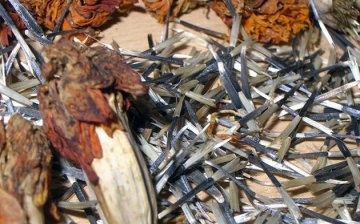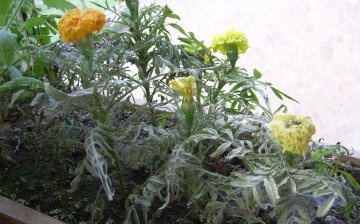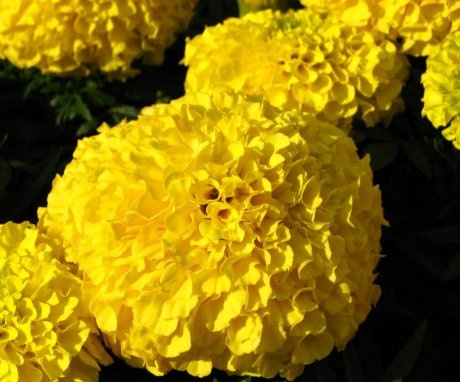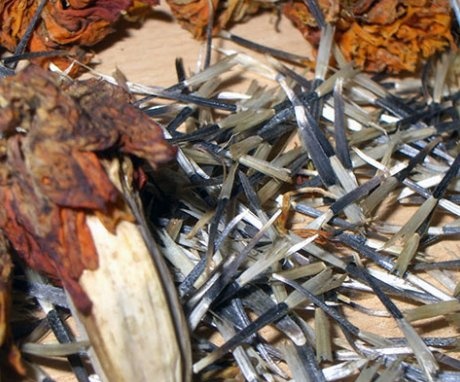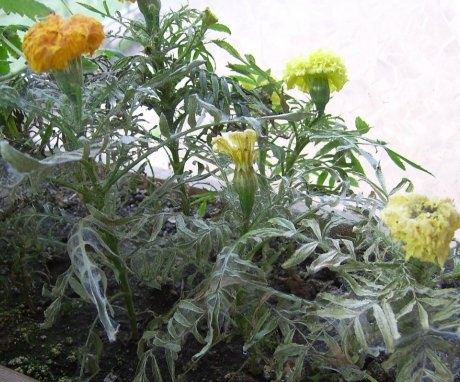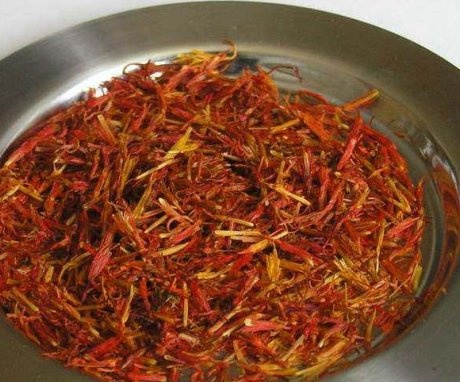Erect marigolds: how to grow them correctly
If geraniums rule on the windowsills of our apartments, which has justly earned the status of the most unpretentious, varied and useful home plant, then the summer cottage has its own leader of the greenskins. It inspires amateur gardeners to create landscape compositions, as it copes with any decorative task, confidently resists bad weather, protects its plant "flock" from diseases and protects from pests.
True Indians - originally from America, so our Tagetes - and this is the name of the flower in Latin - appeared there for the first time. It goes without saying that its name is also telling: according to legend, bright sunny flowers grew in those places where gold deposits could well be located. So, the leader of the garden rightfully received his name from Tages, a descendant of Jupiter, who was famous for his spectacular appearance and the talent of a predictor. We, with love, christened the bright, cheerful flowers marigolds. We will talk in our article about how to understand the numerous species and varieties, grow and breed a popular culture, protect it from diseases and insects.
Content:
- Features of the view
- Growing marigolds erect
- How to breed marigolds
- Possible ailments of flowers
- Harvesting erect marigolds
Features of the view
There is an order fifty types of marigolds.
The most common ones are:
- Rejected.
- Thin-leaved.
- Erect.
They differ in the shape of leaves and inflorescences, height, and the nature of the formation of the bush.
Let's take a closer look at the upright view. These are the tallest plants of the three types. The height of the bush reaches one and a half meters. Interestingly, their leaves give off a stronger scent than the flowers.
Erect marigolds have a second name - African, although this species is native to Central America. The inflorescences of the plant are characterized by a very large size, reaching a diameter of 15 cm. The petals of flowers of all varieties of the family are terry, having a uniform color.
The erect type of marigold is represented by many varieties.
As a rule, they are classified by height, thus highlighting:
- Low-growing varieties that do not grow more than 45 cm.
- Medium varieties, the length of the stems of which ranges from 45-60 cm.
- Tall varieties with a height of 60-90 cm
- Giant varieties reaching a height of 90-150 cm.
As for the plant varieties, because of their large number, it is customary to divide them into varietal groups. So, the flowers of varieties of the same series have the same inflorescence shape, type of petals, stem length. They differ only in the color of the flowers.
The most famous, most often cultivated marigolds of the erect type include the following varieties:
- Antigua. The inflorescences are distinguished by dense tiers of terry petals, and their size is 15 cm. The variety is represented by a rich color palette: there are petals of lemon color, yellow with gold tint, bright sunny shade, orange tone. Bushes grow up to 25 cm, branch well, powerful. They are characterized by abundant flowering.
On the basis of Antigua, hybrid varieties have been developed that are ideal for carpet decoration, since they are absolutely aligned in height and size of flowers.
- Gelber Stein. The inflorescences of this variety of marigolds are very similar to chrysanthemums.They are half as large as Antigua in diameter. But the bushes can grow up to 70 cm. The petals are painted yellow with a golden tint.
- Vanilla. This hybrid variety also belongs to the tall type of upright marigolds. Vanilla stands out for its unusual color of inflorescences. Luxurious flowers up to 15 cm in size have delicate creamy, creamy petals. Terry flower caps are great for cutting.
Growing marigolds erect
Marigolds are so unpretentious to growing conditions that they are quite capable of growing in the most ecologically dangerous places.
For example, along a busy highway, where harmful emissions of carbon dioxide exceed all acceptable standards. Colors have their own preferences, though. Slightly, but they still differ even among species. So, erect marigolds prefer to grow in open spacesx with direct sunlight. In shaded corners, they will still bloom, but not so intensely.
Love marigolds:
- Fertile soils with neutral pH.
- A loamy substrate is well suited for planting and growing.
- If the land at the planting site is not rich in nutrients for good plant growth, you should regularly add top dressing.
- During the growing season, it is recommended to apply it three to four times per season.
- Marigolds are best fertilizers are suitable on an organic and mineral basis.
- The root system of flowers needs oxygen, so it is important to weed and loosen the soil frequently.
- Marigolds are drought tolerant, however, it is optimal to provide them with constant watering, especially at the beginning of the growing season. Otherwise, the flowers are crushed, and the stems and leaves will grow thin.
- Although, a feature of the erect species of marigolds is a poorly tolerated excess of moisture in the soil.
- In the rainy season, their large-sized inflorescences begin to rot, and the root system is affected by diseases of a fungal nature.
The plant belongs to heat-loving flowers, therefore, for the normal development of young shoots, a temperature of at least 20 degrees is required. If the thermometer drops to +10, then the culture stops growing, and the leaves are covered with a specific bloom.
At the slightest minus degrees, marigolds die.
Thus, it should be borne in mind that autumn or spring frosts are extremely dangerous for flowers planted in open ground without shelter.
How to breed marigolds
Marigolds reproduce by seeds.
They can be sown in open soil from the second half of May to mid-June. Young shoots appear within a week and a half. If you cover the soil with artificial acrylic material, then you can sow marigolds a week or two earlier. This is done to speed up the flowering of the crop.
At cultivation of flowers by seedling method, the erect species of marigolds are sown first of all starting in mid-March. So, flowering starts in June. It is best to grow seedlings in greenhouses with plastic foil. A less preferred option is indoor breeding.
The substrate should contain the following parts:
- Sand.
- Sod layer.
- Humus.
- Peat.
The main thing is that the soil is nutritious and loose.
At the same time, the temperature is maintained at a stable level and is equal to 20 degrees of heat. Watering is necessary in moderation.
At the bottom of a box or flowerpot for future seedlings, it is necessary to create drainage. This can be done using materials such as crushed stone, broken brick, expanded clay. There must be through holes on the bottom of the container.
Reproduction by seeds:
- Flower seeds are large, so they can be split into grooves.
- It is important to prevent thickening of the sowing, otherwise the seedlings will suffer from shade.
- It is easiest to maintain the correct distance between plants by sowing germinated planting material.
The germination technique is as follows:
- Seeds are spread on a saucerafter wrapping them in wet gauze.
- Then the container must be wrapped in a plastic bag and placed in a warm place.
- The seeds will swell in two to three days.
- Now they need to be sprinkled with earth, making sure that there is enough layer to prevent drying out, but not excess, since then they will not rise at all.
- The next step is to wate the top layer of soil and cover with paper.
- The boxes are transferred to a warm place with an air temperature of at least 25 degrees Celsius.
- It is important to keep the substrate moist at all times.
- After a week, the air temperature is lowered by 5 degrees, and the emerging shoots begin to light up intensively.
- Dense seedlings should be dived. Transplanting marigolds is allowed at any time.
Possible ailments of flowers
Marigolds show remarkable resistance to diseases and pests.
In many ways, this success is associated with a special substance - phytoncide, which is produced by the leaves of the plant. A beneficial chemical compound repels many parasites. This applies even to those who are in the ground.
However, marigolds can still suffer from disease... Most often these are fungal, nematode and bacterial ailments:
- The plant begins to rot in heavy rains.
- In dry seasons, spider mites appear on marigolds.
- Also, flowers get sick with black leg, root and gray rot.
The black leg has pronounced features. Light changes appear on young stems. Then the spots darken and begin to rot. Due to the numerous constrictions, the flowers wither and die.
For the prevention of the disease it is necessary:
- Disinfect the soil and planting material with a fungicide.
- When watering, potassium permanganate is added to the water.
- This should be done from time to time, since constant use can disrupt the development of seedlings.
- If infection has occurred, young shoots affected by the disease are immediately removed, and the upper part of the soil is dried, limiting watering.
- The soil around the remaining healthy shoots is sprinkled with ash or calcined sand.
- It also helps to prevent further spread of the disease by promptly replanting seedlings into a fresh substrate.
Already grown flowers in open soil can become infected with root rot.
Marigolds slow down growth, leaves and stem turn yellow, and then die. Prevention in this case is good aeration of the soil. Flowers should not be planted in an area where infected plants had previously grown, and fresh manure should not be added as top dressing.
Marigolds are susceptible to viral diseases. This manifests itself in the form of a change in the shape of the leaves, on which streaks of cream and yellow colors appear. The stems of the plant turn yellow. The buds stop developing, and subsequently there are no seeds. Such affected specimens should be removed.
Harvesting erect marigolds
In addition to the fact that the erect look of marigolds is most suitable for both cut bouquets and decoration of flower beds and flower beds, the plant is the most valuable carrier of essential oil, which has a wide range of applications and a solid list of useful substances.
In order to take advantage of all the richness of the crop, you should properly prepare and store the flowers of the plant:
- Marigolds are usually harvested during the profuse flowering stage, which occurs in mid-summer.
- The stems of the plant are cut at a distance of 10 cm from the surface of the earth.
- It is important, however, that the processing of flowers begins as soon as possible.
- You can immediately start drying the flowers tied in bunches.
- The seed pods of marigolds are harvested when the seeds are fully ripe on the main stems and shoots of the first tier of the plant.
- If you do not harvest at this point, the seeds will quickly fall off.
- After the procedure for cutting flowers, it is important to loosen the space between the rows very well.
Varieties of erect marigolds with small inflorescences are also harvested at the stage of abundant flowering.
In small-flowered varieties, this occurs in early autumn.The stems are pruned at a level of 30 cm from the ground surface. After drying the cut seed plants for a short time in a dark and dry place, it is very easy to remove the seeds.
The raw material for the production of essential oil is only the fresh green part of the plant located on the soil surface.
The essential oil is fairly easy to extract with steam or using volatile solvents. Also marigolds are used in cooking in as a spice... For these purposes, the flowers are dried in the shade. This is due to the fact that in the sun the quality and quantity of oils contained in marigolds is significantly reduced.
In any case, whether you use the special qualities of marigolds or they begin to perform a decorative function, these flowers appreciate the caring attitude, presenting the owners with abundant, long-lasting flowering and a rich harvest for the home pharmacy.
More information can be found in the video.






